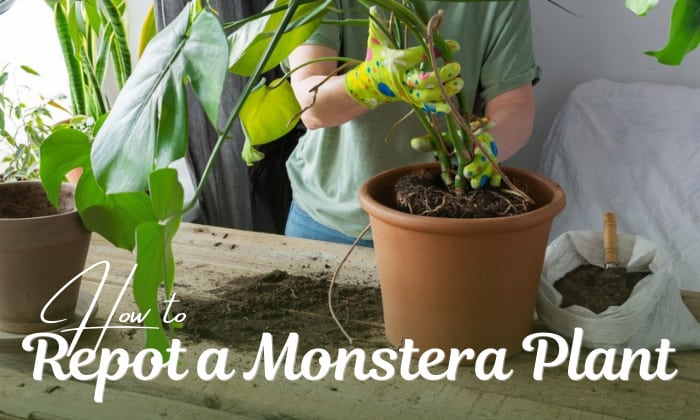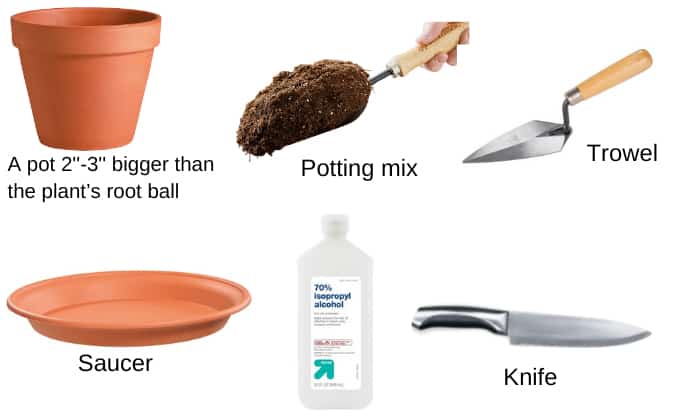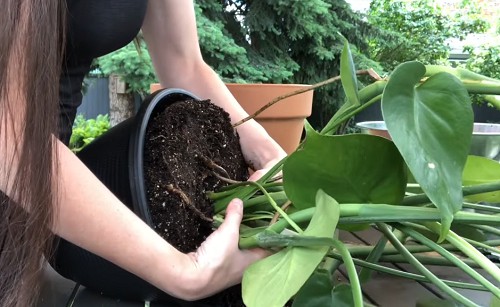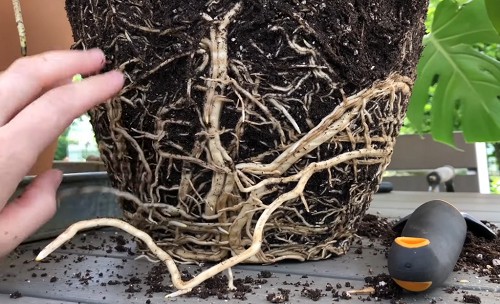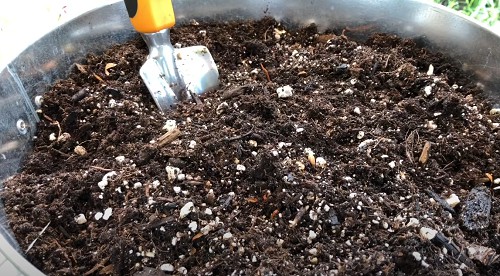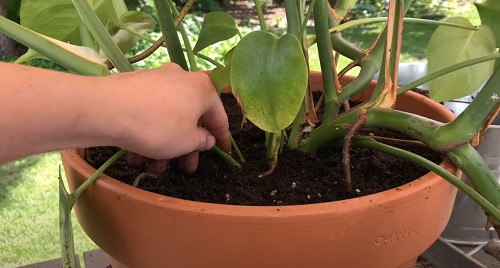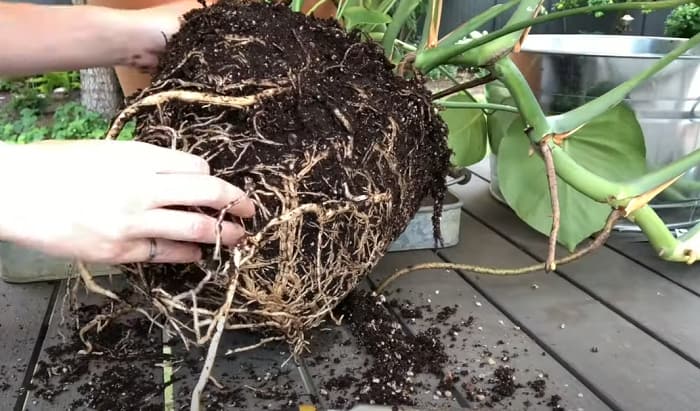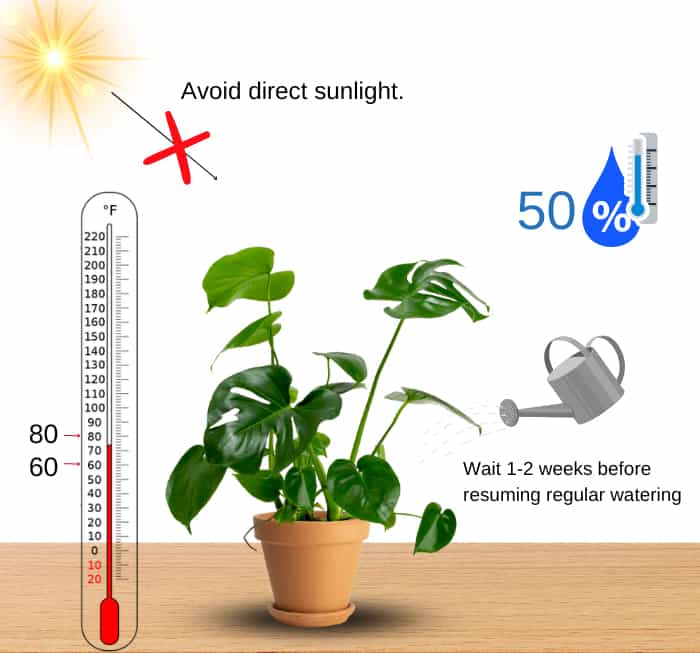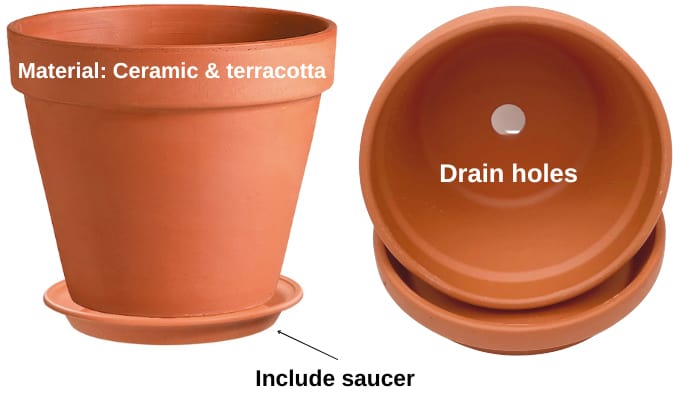Monstera plants are known for their stunning heart-shaped and sometimes split leaves, depending on what variety of plant you have. Though they are low-maintenance, it’s necessary to give monsteras the proper care to preserve their elegant foliage and ensure continuous growth.
If you’re unsure how to repot a monstera plant, read below.
Table of Contents
Guide for Repotting Monstera
What to prepare
- A pot two to three inches bigger than the plant’s root ball (with drain holes)
If your monstera has reached full growth, you may use the same size pot you currently have, provided it meets the requirement above.
But first, ensure you clean the pot with soap to eliminate bacteria and other microorganisms that can ruin the new soil.
- Potting mix
To create a monstera soil mix, combine equal parts of perlite and coconut coir with twice as much potting soil. You may also use charcoal, worm castings, bark, pumice, and coir in a 1:1:3:3:3 ratio.
- A moss pole that’s taller than your plant
Staking your plant with pole is optional, but it’s advisable if you’re repotting monstera with aerial roots or one that’s very tall and heavy. If you intend to use a pole, prepare some velcro strips or wires to help stake the plant down.
- Trowel
- Water
- Saucer
- Scissors and rubbing alcohol (70 to 100%) for tool disinfection
- Knife
- Tarp or cover to keep things clean
Steps for transplanting monstera
If your monstera’s getting too big for its pot, follow the steps below to replant it.
Step 1. Remove the monstera from its container.
Water the soil to make removing your plant easier.
Afterward, upend the pot or wiggle it to get the plant out. If you have trouble completing this step, run a knife along the rim of the pot or use a trowel to break up the soil.
Remember to grab the stems gently while removing the monstera.
Step 2. Trim off diseased roots and leaves
- Loosen the roots of the plant with your fingers. If you see any old soil, shake it off as well.
- Before we move on to the next step, check the monstera for moldy, rotten roots, and dead leaves, then cut them off to give your plant a fresh start.
Note that though people generally repot monsteras to encourage their growth, you may also limit their expansion by cutting off ⅓ of the roots. In this case, you won’t need to upsize your container, though it’s still wise to give it new soil.
While you’re doing this step, avoid messing with aerial stems if they’re healthy.
Step 3. Replant your large monstera.
Fill a third of the new pot with your soil mix. Put the monstera plant into the pot, followed by the moss pole if you use it.
Note that with moss pole in place, your plant will grow upwards instead of outwards, so consider whether you want a tall or bushy monstera beforehand.
Afterward, tie the stems to the pole, and pour in more soil so that only two inches of space separate the roots from the container edge.
Tamp down the plant mix with your fingers, then water the medium until moisture drips from the drain holes. Catch the excess water with a saucer before dumping it.
When Should I Repot My Monstera?
The general recommendation is to replant a monstera every two to three years. However, the following indicators will prove more useful, since we know different plants grow at different rates:
- The roots form circles at the bottom.
- The soil lacks nutrients or no longer retains moisture.
- The roots are coming out of pot through the drain holes.
- Stagnant growth or discolored leaves despite proper care
- Fertilizing does not improve the plant mix.
- The foliage spread is three times bigger than the pot, making the plant wobbly.
- Monstera plant roots growing out of pot and reaching the rim
- The nursery or seller uses chemical fertilizers or steroids to make the plant more appealing, or there is salt in the soil. In these situations, change containers after buying.
When possible, do this task in spring or late winter before dormancy ends to minimize monstera repotting shock. Note that it’s ideal to repot monstera in summer as well, preferably on a humid day.
If your Swiss-cheese plant unfortunately has root rot, it doesn’t matter when you move it (in winter, fall, or otherwise). As early as possible would be ideal.
Read more: Steps to repot other plants such as an aloe vera plant and succulents.
Care Instructions
You already know how often to repot monstera, but how to care for the plant after replanting? Consider the tips below.
- Give monsteras 50% humidity, either by using a humidifier or a mist sprayer.
- Regardless of the variety, the plant does not enjoy harsh, direct sunlight, so place it near a closed glass window.
Note that if you’re repotting monstera adansonii, it can withstand darker environments than a monstera deliciosa. I tend to repot monstera deliciosa and place it in a brighter area so that it has more splits.
- Grow your plant under 60 to 80 degrees Fahrenheit, with 55 and 90 degrees as the lowest and highest limits. If you put your monstera outside, 60 degrees is the minimum to ensure plant health.
- After repotting, wait one or two weeks before resuming regular watering, and do not water unless the soil is dry.
- If you use fertilizer, let the plant adjust for a month before feeding it, preferably with a 5-2-3 NPK formula in liquid forms.
Type of Pot for Monstera
The best kind of pot for monstera is well-drained and breathable, such as those made of ceramic and terracotta. You should choose containers with a built-in saucer as well, or buy the tray separately for convenient irrigation.
When using planters without drain holes, put the monstera in plastic nursery liners to water it. Once the liquid finishes draining, transfer the nursery liner and plant into the watertight planter for display.
Last but not least, know how big of a pot you need. To reiterate what we said above, go up two to three inches in pot diameter, unless you’re pruning the montsera to control its size.
FAQs
Is the split-leaf philodendron monstera deliciosa?
Technically, no. Split-leaf philodendrons and monstera deliciosa both belong to the arum family, but they grow to different heights and have different foliage.
Monsteras, in particular, possess more sizable leaves with a smoother texture and reach 10 feet at the maximum rather than 20 feet like their counterpart.
The confusion stems from the fact that their common names are often used interchangeably. So, remember the scientific designation of split-leaf philodendrons, which is Thaumatophyllum bipinnatifidum.
How to grow monstera plants from cuttings?
- Pick a stem with at least four leaves and a node, then cut your selection from the plant stalk.
- Remove all foliage below the node, save for one leaf at the top.
- Put the cutting in a transparent glass of water and wait for the roots to form. Change the liquid weekly until roots appear, at which point you can move the clipping from water to soil.
Conclusion
Monsteras are excellent houseplants due to their air-purifying capacity. If you know how to repot a monstera plant, caring for it the rest of the time should not be an issue.
After all, this arum doesn’t require much in terms of watering or sunlight. Provided you keep it away from your pets and curious children, it should not cause you any trouble.

Hi, I am William – Floridayards’ digital content creator. My job is to find answers to all your concerns with thorough research and our team’s expert advice. I will also bring you honest reviews on the best products and equipment for raising your beautiful garden. Please look forward to our work!


